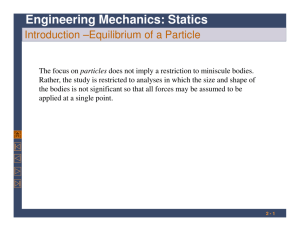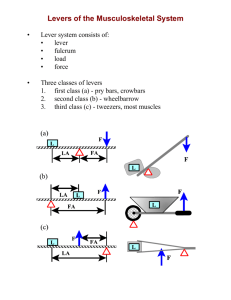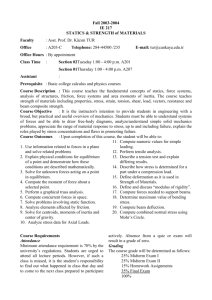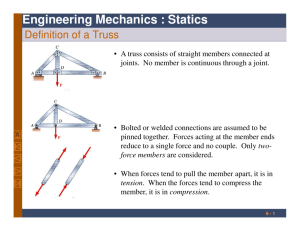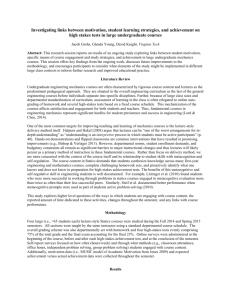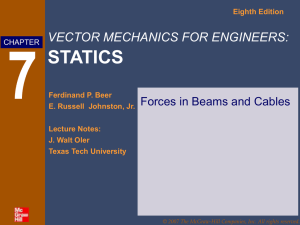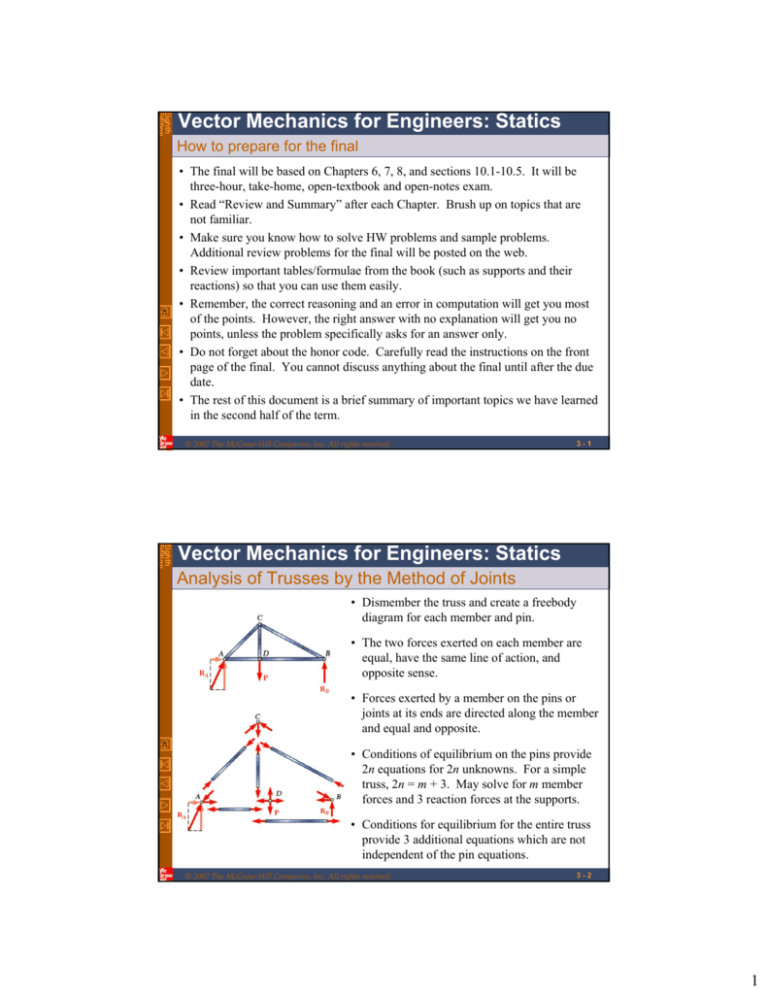
Eighth
Edition
Vector Mechanics for Engineers: Statics
How to prepare for the final
• The final will be based on Chapters 6, 7, 8, and sections 10.1-10.5. It will be
three-hour, take-home, open-textbook and open-notes exam.
• Read “Review and Summary” after each Chapter. Brush up on topics that are
not familiar.
• Make sure you know how to solve HW problems and sample problems.
Additional review problems for the final will be posted on the web.
• Review important tables/formulae from the book (such as supports and their
reactions) so that you can use them easily.
• Remember, the correct reasoning and an error in computation will get you most
of the points. However, the right answer with no explanation will get you no
points, unless the problem specifically asks for an answer only.
• Do not forget about the honor code. Carefully read the instructions on the front
page of the final. You cannot discuss anything about the final until after the due
date.
• The rest of this document is a brief summary of important topics we have learned
in the second half of the term.
© 2007 The McGraw-Hill Companies, Inc. All rights reserved.
3-1
Eighth
Edition
Vector Mechanics for Engineers: Statics
Analysis of Trusses by the Method of Joints
• Dismember the truss and create a freebody
diagram for each member and pin.
• The two forces exerted on each member are
equal, have the same line of action, and
opposite sense.
• Forces exerted by a member on the pins or
joints at its ends are directed along the member
and equal and opposite.
• Conditions of equilibrium on the pins provide
2n equations for 2n unknowns. For a simple
truss, 2n = m + 3. May solve for m member
forces and 3 reaction forces at the supports.
• Conditions for equilibrium for the entire truss
provide 3 additional equations which are not
independent of the pin equations.
© 2007 The McGraw-Hill Companies, Inc. All rights reserved.
3-2
1
Eighth
Edition
Vector Mechanics for Engineers: Statics
Analysis of Trusses by the Method of Sections
• When the force in only one member or the
forces in a very few members are desired, the
method of sections works well.
• To determine the force in member BD, pass a
section through the truss as shown and create
a free body diagram for the left side.
• With only three members cut by the section,
the equations for static equilibrium may be
applied to determine the unknown member
forces, including FBD.
© 2007 The McGraw-Hill Companies, Inc. All rights reserved.
3-3
Eighth
Edition
Vector Mechanics for Engineers: Statics
Machines
• Machines are structures designed to transmit
and modify forces. Their main purpose is to
transform input forces into output forces.
• Given the magnitude of P, determine the
magnitude of Q.
• Create a free-body diagram of the complete
machine, including the reaction that the wire
exerts.
• The machine is a nonrigid structure. Use
one of the components as a free-body.
• Taking moments about A,
∑ M A = 0 = aP − bQ
© 2007 The McGraw-Hill Companies, Inc. All rights reserved.
Q=
a
P
b
3-4
2
Eighth
Edition
Vector Mechanics for Engineers: Statics
Shear and Bending Moment Diagrams
• Variation of shear and bending
moment along beam may be
plotted.
• Determine reactions at
supports.
• Cut beam at C and consider
member AC,
V = + P 2 M = + Px 2
• Cut beam at E and consider
member EB,
V = − P 2 M = + P(L − x ) 2
• For a beam subjected to
concentrated loads, shear is
constant between loading points
and moment varies linearly.
© 2007 The McGraw-Hill Companies, Inc. All rights reserved.
3-5
Eighth
Edition
Vector Mechanics for Engineers: Statics
Relations Among Load, Shear, and Bending Moment
• Relations between load and shear:
V − (V + ΔV ) − wΔx = 0
dV
ΔV
= lim
= −w
dx Δx →0 Δx
xD
VD − VC = − ∫ w dx = −(area under load curve)
xC
• Relations between shear and bending moment:
(M + ΔM ) − M − VΔx + wΔx Δx = 0
2
dM
ΔM
= lim V − 12 wΔx = V
= lim
dx Δx →0 Δx Δx →0
(
)
xD
M D − M C = ∫ V dx = (area under shear curve)
xC
© 2007 The McGraw-Hill Companies, Inc. All rights reserved.
3-6
3
Eighth
Edition
Vector Mechanics for Engineers: Statics
Relations Among Load, Shear, and Bending Moment
• Reactions at supports,
R A = RB =
wL
2
• Shear curve,
x
V − V A = − ∫ w dx = − wx
0
V = V A − wx =
wL
⎛L
⎞
− wx = w⎜ − x ⎟
2
⎠
⎝2
• Moment curve,
x
M − M A = ∫ Vdx
0
(
x
w
⎛L
⎞
M = ∫ w⎜ − x ⎟dx = L x − x 2
2
2
⎝
⎠
0
M max =
wL2
8
)
dM
⎛
⎞
= V = 0⎟
⎜ M at
dx
⎝
⎠
© 2007 The McGraw-Hill Companies, Inc. All rights reserved.
3-7
Eighth
Edition
Vector Mechanics for Engineers: Statics
Sample Problem 7.4
SOLUTION:
• Taking entire beam as a free-body, determine
reactions at supports.
• Between concentrated load application
points, dV dx = − w = 0 and shear is
constant.
Draw the shear and bendingmoment diagrams for the beam
and loading shown.
• With uniform loading between D and E, the
shear variation is linear.
• Between concentrated load application
points, dM dx = V = constant . The change
in moment between load application points is
equal to area under shear curve between
points.
• With a linear shear variation between D
and E, the bending moment diagram is a
parabola.
© 2007 The McGraw-Hill Companies, Inc. All rights reserved.
3-8
4
Eighth
Edition
Vector Mechanics for Engineers: Statics
Sample Problem 7.4
• Between concentrated load application
points, dM dx = V = constant . The change
in moment between load application points is
equal to area under the shear curve between
points.
M B − M A = +108
M C − M B = −16
M B = +108 kip ⋅ ft
M C = +92 kip ⋅ ft
M D − M C = −140 M D = −48 kip ⋅ ft
M E − M D = +48 M E = 0
• With a linear shear variation between D
and E, the bending moment diagram is a
parabola.
© 2007 The McGraw-Hill Companies, Inc. All rights reserved.
3-9
Eighth
Edition
Vector Mechanics for Engineers: Statics
Cables With Concentrated Loads
• Consider entire cable as free-body. Slopes of
cable at A and B are not known - two reaction
components required at each support.
• Four unknowns are involved and three
equations of equilibrium are not sufficient to
determine the reactions.
• Additional equation is obtained by
considering equilibrium of portion of cable
AD and assuming that coordinates of point D
on the cable are known. The additional
equation is ∑ M D = 0.
• For other points on cable,
∑ M C2 = 0 yields y2
∑ Fx = 0, ∑ Fy = 0 yield Tx , T y
• Tx = T cosθ = Ax = constant
© 2007 The McGraw-Hill Companies, Inc. All rights reserved.
3 - 10
5
Eighth
Edition
Vector Mechanics for Engineers: Statics
Cables With Distributed Loads
• For cable carrying a distributed load:
a) cable hangs in shape of a curve
b) internal force is a tension force directed along
tangent to curve.
• Consider free-body for portion of cable extending
from lowest point C to given point D. Forces are
horizontal force T0 at C and tangential force T at D.
• From force triangle:
T cosθ = T0
T sin θ = W
W
T0
• Horizontal component of T is uniform over cable.
• Vertical component of T is equal to magnitude of W
measured from lowest point.
• Tension is minimum at lowest point and maximum
at A and B.
T = T02 + W 2
tan θ =
© 2007 The McGraw-Hill Companies, Inc. All rights reserved.
3 - 11
Eighth
Edition
Vector Mechanics for Engineers: Statics
Parabolic Cable
• Consider a cable supporting a uniform, horizontally
distributed load, e.g., support cables for a
suspension bridge.
• With loading on cable from lowest point C to a
point D given by W = wx , internal tension force
magnitude and direction are
wx
T = T02 + w 2 x 2
tan θ =
T0
• Summing moments about D,
x
wx − T0 y = 0
∑MD = 0:
2
or
wx 2
y=
2T0
The cable forms a parabolic curve.
© 2007 The McGraw-Hill Companies, Inc. All rights reserved.
3 - 12
6
Eighth
Edition
Vector Mechanics for Engineers: Statics
Catenary
• Consider a cable uniformly loaded along the cable
itself, e.g., cables hanging under their own weight.
• With loading on the cable from lowest point C to a
point D given by W = ws , the internal tension force
magnitude is
T = T02 + w 2 s 2 = w c 2 + s 2
c=
T0
w
• To relate horizontal distance x to cable length s,
T
ds
dx = ds cosθ = 0 cosθ =
T
q + s2 c2
s
x=∫
0
ds
q+s
2
c
2
= c sinh −1
s
c
and s = c sinh
© 2007 The McGraw-Hill Companies, Inc. All rights reserved.
x
c
3 - 13
Eighth
Edition
Vector Mechanics for Engineers: Statics
Catenary
• To relate x and y cable coordinates,
W
s
x
dy = dx tan θ = dx = dx = sinh dx
T0
c
c
x
y − c = ∫ sinh
0
y = c cosh
x
x
dx = c cosh − c
c
c
x
c
which is the equation of a catenary.
© 2007 The McGraw-Hill Companies, Inc. All rights reserved.
3 - 14
7
Eighth
Edition
Vector Mechanics for Engineers: Statics
The Laws of Dry Friction. Coefficients of Friction
• Four situations can occur when a rigid body is in contact with
a horizontal surface:
• No friction,
(Px = 0)
• No motion,
(Px < Fm)
• Motion impending,
(Px = Fm)
• Motion,
(Px > Fm)
© 2007 The McGraw-Hill Companies, Inc. All rights reserved.
3 - 15
Eighth
Edition
Vector Mechanics for Engineers: Statics
Wedges
• Wedges - simple
machines used to raise
heavy loads.
• Friction prevents wedge
from sliding out.
• Want to find minimum
force P to raise block.
• Block as free-body
∑ Fx = 0 :
− N1 + μ s N 2 = 0
∑ Fy = 0 :
− W − μ s N1 + N 2 = 0
or
G G
K
R1 + R2 + W = 0
© 2007 The McGraw-Hill Companies, Inc. All rights reserved.
• Wedge as free-body
∑ Fx = 0 :
− μ s N 2 − N 3 (μ s cos 6° − sin 6°)
+P=0
F
∑ y = 0:
− N 2 + N 3 (cos 6° − μ s sin 6°) = 0
or
G G
G
P − R2 + R3 = 0
3 - 16
8
Eighth
Edition
Vector Mechanics for Engineers: Statics
Square-Threaded Screws
• Square-threaded screws frequently used in jacks, presses, etc.
Analysis similar to block on inclined plane. Recall friction
force does not depend on area of contact.
• Thread of base has been “unwrapped” and shown as straight
line. Slope is 2πr horizontally and lead L vertically.
• Moment of force Q is equal to moment of force P. Q = Pa r
• Impending motion
upwards. Solve for
Q.
• φs > θ , Self-locking, solve
for Q to lower load.
• φs > θ , Non-locking, solve
for Q to hold load.
© 2007 The McGraw-Hill Companies, Inc. All rights reserved.
3 - 17
Eighth
Edition
Vector Mechanics for Engineers: Statics
Journal Bearings. Axle Friction
• Angle between R and
normal to bearing
surface is the angle of
kinetic friction ϕk.
M = Rr sin φ k
• May treat bearing
reaction as forcecouple system.
≈ Rrμ k
© 2007 The McGraw-Hill Companies, Inc. All rights reserved.
• For graphical solution,
R must be tangent to
circle of friction.
r f = r sin φ k
≈ rμ k
3 - 18
9
Eighth
Edition
Vector Mechanics for Engineers: Statics
Belt Friction
• Relate T1 and T2 when belt is about to slide to right.
• Draw free-body diagram for element of belt
Δθ
Δθ
∑ Fx = 0 : (T + ΔT ) cos − T cos − μ s ΔN = 0
2
2
Δθ
Δθ
∑ Fy = 0 : ΔN − (T + ΔT ) sin − T sin = 0
2
2
• Combine to eliminate ΔN, divide through by Δθ,
ΔT
Δθ
ΔT ⎞ sin (Δθ 2 )
⎛
cos
− μ s ⎜T +
⎟
Δθ
2
2 ⎠ Δθ 2
⎝
• In the limit as Δθ goes to zero,
dT
− μ sT = 0
dθ
• Separate variables and integrate from θ = 0 to θ = β
T
T2
ln 2 = μ s β or
= e μs β
T1
T1
© 2007 The McGraw-Hill Companies, Inc. All rights reserved.
3 - 19
Eighth
Edition
Vector Mechanics for Engineers: Statics
Principle of Virtual Work
• Imagine a small virtual displacement of a particle which
is acted upon by several forces.
• The corresponding virtual work,
G G G G G G
G G
G
G
δU = F1 ⋅ δr + F2 ⋅ δr + F3 ⋅ δr = (F1 + F2 + F3 )⋅ δr
G G
= R ⋅ δr
Principle of Virtual Work:
• A particle is in equilibrium if and only if the total virtual
work of forces acting on the particle is zero for any virtual
displacement.
• A rigid body is in equilibrium if and only if the total
virtual work of external forces acting on the body is
zero for any virtual displacement of the body.
• If a system of connected rigid bodies remains connected
during the virtual displacement, only the work of the
external forces need be considered.
© 2007 The McGraw-Hill Companies, Inc. All rights reserved.
3 - 20
10
Eighth
Edition
Vector Mechanics for Engineers: Statics
Sample Problem 10.1
Determine the magnitude of the couple M required to
maintain the equilibrium of the mechanism.
SOLUTION:
• Apply the principle of virtual work
δU = 0 = δU M + δU P
0 = Mδθ + PδxD
xD = 3l cosθ
δxD = −3l sin θδθ
0 = Mδθ + P (− 3l sin θδθ )
M = 3Pl sin θ
© 2007 The McGraw-Hill Companies, Inc. All rights reserved.
3 - 21
Eighth
Edition
Vector Mechanics for Engineers: Statics
Potential Energy and Equilibrium (not covered in the final)
• When the potential energy of a system is known,
the principle of virtual work becomes
dV
δU = 0 = −δV = − δθ
dθ
dV
0=
dθ
• For the structure shown,
V = Ve + V g = 12 kx B2 + WyC
= 12 k (2l sin θ )2 + W (l cosθ )
• At the position of equilibrium,
dV
= 0 = l sin θ (4kl cosθ − W )
dθ
indicating two positions of equilibrium.
© 2007 The McGraw-Hill Companies, Inc. All rights reserved.
3 - 22
11
Eighth
Edition
Vector Mechanics for Engineers: Statics
Stability of Equilibrium (not covered in the final)
dV
=0
dθ
d 2V
dθ
2
>0
© 2007 The McGraw-Hill Companies, Inc. All rights reserved.
d 2V
<0
dθ 2
Must examine higher
order derivatives.
3 - 23
12


